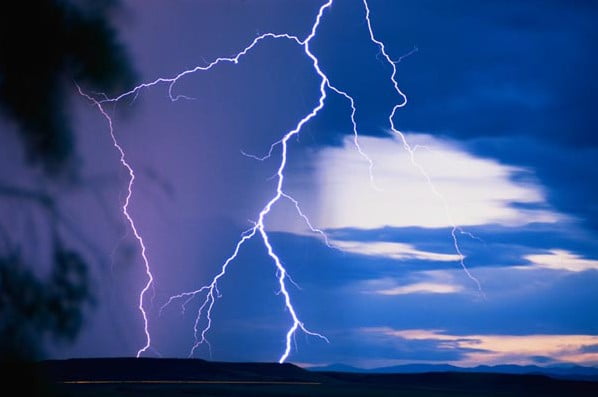A
Acid rain
Rain that is more acidic than normal because water vapour has condensed on to particles of sulphate or nitrogen oxide.
Advection
The transfer of some property (e.g. temperature or moisture) by the horizontal movement of air or water, such as wind or ocean current.
Advection fog
Fog caused by the condensation of water vapour when warm, moist air crosses cold ground or sea.
Aerosol
A suspension of microscopic liquid and solid particles in the atmosphere for at least a few hours. Can be natural or anthropogenic (man-made).
Air
A naturally occurring mixture of gases, chiefly nitrogen and oxygen with small amounts of argon, carbon dioxide and water vapour- we sometimes call this our atmosphere
Airmass
A large area of air which has similar temperature and humidity characteristics.
Air pressure
The weight of the atmosphere pressing down on the Earth’s surface as a result of gravity.
Altitude
The height of the something above sea level. It is usually measured in feet or metres. Sea level is an altitude of 0 m.
Anemometer
An instrument for measuring the speed of wind
Anticyclone
A large are of high atmospheric pressure, characterised by outward-spiralling winds- a ‘high’. In the northern hemisphere winds rotate around an anticyclone in a clockwise direction.
Atmosphere
An envelope of gases surrounding the Earth. The main gases are nitrogen and oxygen, with smaller amounts of other gases such as water vapour, carbon dioxide and methane.
B
Barometer
An instrument for measuring atmospheric pressure
Beaufort scale
A scale that indicates wind speed by the effect wind has on familiar objects.
Biofuel
Any fuel (liquid, solid or gas) produced from organic matter (matter from animals or plants).
Blizzard
Blowing snow reduces surface visibility. There are low temperatures, strong winds and heavy snow.
C
Celsius
A scale of temperature based on one introduced in 1742 by Celsius, a Swedish astronomer and physicist, who divided the interval between the freezing and boiling points of water into 100 parts. The present system, where the freezing point is marked 0 and the boiling point is marked as 100, was introduced by Christin Lyons in 1743.
Climate
The long term (often taken as 30 years) average weather pattern of a region.
Cloud
A structure formed in the atmosphere by condensed water vapour.
Cold front
The boundary between two different air masses where the cold air pushes the warm air out of way and brings colder weather.
Condensation
The process by which water vapour becomes liquid water.
Conduction
The process of heat transfer through materials by molecular motion.
Convection
The process of heat transfer through fluids by means of rising currents.
Coriolis force
An effect caused by the Earth’s rotation, which causes winds and currents to follow a curved path across the Earth’s surface- to the right in the northern hemisphere, to the left in the southern hemisphere.
Cyclone
A large area of low atmospheric pressure, characterised by inward-spiralling wind often called a ‘low’ or a ‘depression’. Also the name used for a hurricane in the Indian Ocean and Western Pacific.
D
Depression
A low-pressure weather system.
Dew
Liquid water that has condensed on to objects at or near the Earth’s surface.
Dew point
The temperature below which water droplets can form in the air.
Downburst
A strong downdraught of short duration produced by some thunderstorms.
Drizzle
Very small droplets of liquid precipitation.
E
Evaporation
The process where liquid water turns into vapour (e.g. a rain puddle may evaporate into water vapour when the sun comes out). It is the opposite of condensation.
Eye
Centre of a hurricane
F
Fahrenheit
A scale of temperature introduced in about 1709 by the German Physicist, Fahrenheit, who was the first to use mercury as a thermometric substance. Primary fixed points were the temperatures of a mixture of common salt and ice and the temperature of the human body; with reference to these the freezing point of water was marked 32 degree and the boiling point of water was marked 212 degrees.
Fog
Water droplets in the air that reduce visibility to less than 1000m (1100 yards).
Front
The boundary between two air masses.
Frost
White ice crystals deposited on the surface of objects that have a temperature below the freezing point of water.
G
Global Warming
The increase in global mean temperature, linked to the artificial increase in greenhouse gas concentrations.
Greenhouse Gases
Gases which absorb some of the outgoing radiation from Earth and re-emit it back down towards Earth.
H
Hail
Pieces of hard, solid ice falling from clouds.
Hemisphere
One half of a sphere. The term is usually applied to regions north or south of the equator or east or west of the Prime (Greenwich) meridian.
High
Also known as an anticyclone- an area of high pressure with a system of winds rotating outwards. This usually means dry weather.
Humidity
The amount of water vapour in the air. May be absolute or relative.
Hurricane
A tropical revolving storm with sustained wind speeds of more than 118km/h (73mph). It is called a hurricane in the North Atlantic, but in other parts of the world it is known as a typhoon or tropical cyclone.
I
Isobar
A line on a map or chart that links points of equal atmospheric pressure.
J
Jet stream
A strong, high level wind that can reach speeds in excess of 320km/h (200mph) – it is usually around 5-10km (3-6 miles) above the ground.
K
Katabatic wind
A wind which blows down a slope.
L
Latitude
Position on the Earth’s surface north or south of the equator.
Lee
The side of a mountain, hillside or island what is facing away from the prevailing wind.
Lightning
Discharge of static electricity in the atmosphere, usually between the ground and a storm cloud.
Longitude
Position on the Earth’s surface east or west of the Greenwich (prime) meridian.
Low
Also called a depression- this region of low pressure can mean wet weather- it is the opposite of high pressure or anticyclone.
M
Meteorologist
Someone who makes a scientific study of weather, weather processes and/or the climate.
Meteorology
The science of the atmosphere- meteorology embraces both weather and climate and is concerned with all aspects of the Earth’s atmosphere (and those of the planets) and with the interaction between the atmosphere and the surface. The term was first used by Aristotle.
Millibar
Unit for measuring air pressure. Now a hectoPascal (hPa) is the standard unit for pressure.
Monsoon
The seasonal shift in wind direction that brings alternate very wet and very dry seasons to India and much of South-East Asia and other regions.
N
O
Occluded front
The combination of warm and cold fronts as a cold front overtakes a warm front. The front develops during the later stage of the life cycle of a frontal depression and is so called because of the associated occluding (shutting off) the warm air from the Earth’s surface.
P
Precipitation
Moisture that is released from the atmosphere as rain, drizzle, hail, sleet or snow.
Q
R
Radiation
Process by which energy travels across space.
Rainbow
A rainbow appears when sunlight shines through water droplets in the air. White light is made of seven colours. As the light shines through the water droplets the light is bent. The different colours of light bend by different amounts, so they separate and become visible.
S
Sea-level
The normal level of high tide, used as a baseline for measuring height or depth.
Snowline
The vertical limit of snow lying on mountain side throughout the year.
Synoptic chart
A map showing large-scale weather patterns in an area at a given time.
T
Temperature
The heat content of the air.
Thunder
Sound caused by intense heating of the air by lightning.
Typhoon
A name of Chinese origin, meaning ‘great wind’ applied to the intense tropical cyclones which occur in the western Pacific Ocean. They are the same as the hurricanes of the Atlantic Ocean and the cyclones of the Bay of Bengal.
U
V
W
Warm front
The boundary between two different air masses where warm air pushes cold air away to bring warmer weather.
Water vapour
Water in its gas form. The proportion of water vapour in the air varies with time and place. The dominant greenhouse gas.
Weather
The state of the atmosphere (with regard to wind strength and direction, temperature, precipitation and pressure) at a specific time and place.
X
Y
Z
 Sunshine is essential for life on our planet. The existence of all plants, animals and life on land and sea depends on the Sun. The movement of the atmosphere and the oceans are powered by the Sun.
Sunshine is essential for life on our planet. The existence of all plants, animals and life on land and sea depends on the Sun. The movement of the atmosphere and the oceans are powered by the Sun. 

 Thunder is the loud noise which follows a flash of lightning. Lightning can be seen before thunder is heard as light travels faster than sound. The speed of sound in air is just over 300m/s. This means that if you count the seconds between seeing the lightning and hearing the thunder, and divide by three, you can work out how many kilometres away the storm is (for example, if you start counting when you see the lightning and get to 9, then the storm is about 3km away). The noise of thunder is caused by the rapid expansion of heating the air. You can normally hear thunder up to 6 miles (10km) away from the lightning flash. The sound can last quite a few seconds!
Thunder is the loud noise which follows a flash of lightning. Lightning can be seen before thunder is heard as light travels faster than sound. The speed of sound in air is just over 300m/s. This means that if you count the seconds between seeing the lightning and hearing the thunder, and divide by three, you can work out how many kilometres away the storm is (for example, if you start counting when you see the lightning and get to 9, then the storm is about 3km away). The noise of thunder is caused by the rapid expansion of heating the air. You can normally hear thunder up to 6 miles (10km) away from the lightning flash. The sound can last quite a few seconds! Lightning can be seen virtually instantaneously as light travels very fast (about 300,000,000 m/s!). Lightning can be seen up to 50 miles away! lightning. Lightning is produced by discharges of electricity from cloud to cloud or from cloud to ground. A large positive charge builds up in the upper part of a thunder cloud and a negative charge builds up near the base of the cloud. When the potential difference between the charged areas becomes large enough, electrical energy is discharged and a flash of lightning occurs. Huge quantities of electricity are discharged in lightning flashes and temperatures of over 30,000°C or more can be reached!
Lightning can be seen virtually instantaneously as light travels very fast (about 300,000,000 m/s!). Lightning can be seen up to 50 miles away! lightning. Lightning is produced by discharges of electricity from cloud to cloud or from cloud to ground. A large positive charge builds up in the upper part of a thunder cloud and a negative charge builds up near the base of the cloud. When the potential difference between the charged areas becomes large enough, electrical energy is discharged and a flash of lightning occurs. Huge quantities of electricity are discharged in lightning flashes and temperatures of over 30,000°C or more can be reached! In a thunderstorm you should not stand under a tree! Lightning tends to strike the highest point around and everything near this can be a target for the lightning too. Very few people survive being hit by lightning. To increase your safety in a thunderstorm you should avoid high ground, water, open spaces such as parks and golf courses, staying in a tent or shed, being within 30m of wire fences or using your umbrella. You should make yourself as small as possible – curling up in a ball is good. It is however safe to stay in the car…do you know why?! It is because the car acts as what is known as a Faraday cage, protecting you from the electric field generated by the storm.
In a thunderstorm you should not stand under a tree! Lightning tends to strike the highest point around and everything near this can be a target for the lightning too. Very few people survive being hit by lightning. To increase your safety in a thunderstorm you should avoid high ground, water, open spaces such as parks and golf courses, staying in a tent or shed, being within 30m of wire fences or using your umbrella. You should make yourself as small as possible – curling up in a ball is good. It is however safe to stay in the car…do you know why?! It is because the car acts as what is known as a Faraday cage, protecting you from the electric field generated by the storm. For thunderstorms to occur, cumulonimbus clouds are required. These are heavy, dense, towering clouds with tops shaped like anvils or vast plumes, where the speed of air rising through the cloud can reach 20m/s. Pilots tend to fly around these clouds if they can. They can fly around them as often they are only 10-12km in width. In cumulonimbus clouds weather such as heavy rain, lightning, hail, turbulence and strong winds can occur.
For thunderstorms to occur, cumulonimbus clouds are required. These are heavy, dense, towering clouds with tops shaped like anvils or vast plumes, where the speed of air rising through the cloud can reach 20m/s. Pilots tend to fly around these clouds if they can. They can fly around them as often they are only 10-12km in width. In cumulonimbus clouds weather such as heavy rain, lightning, hail, turbulence and strong winds can occur.

